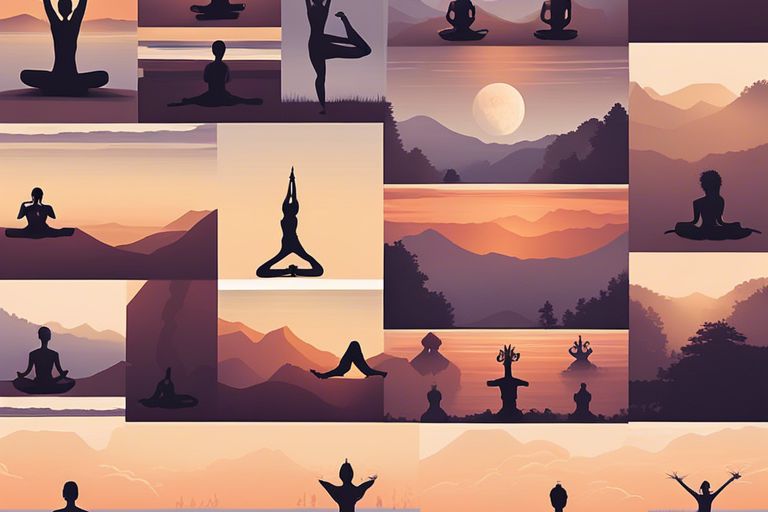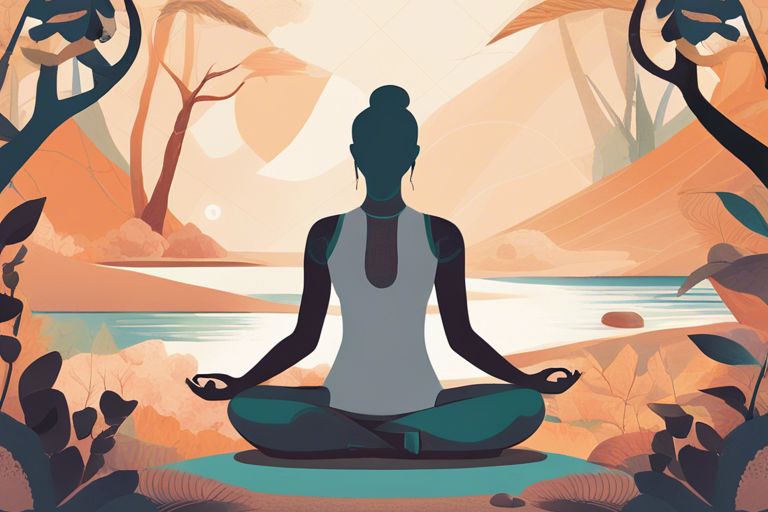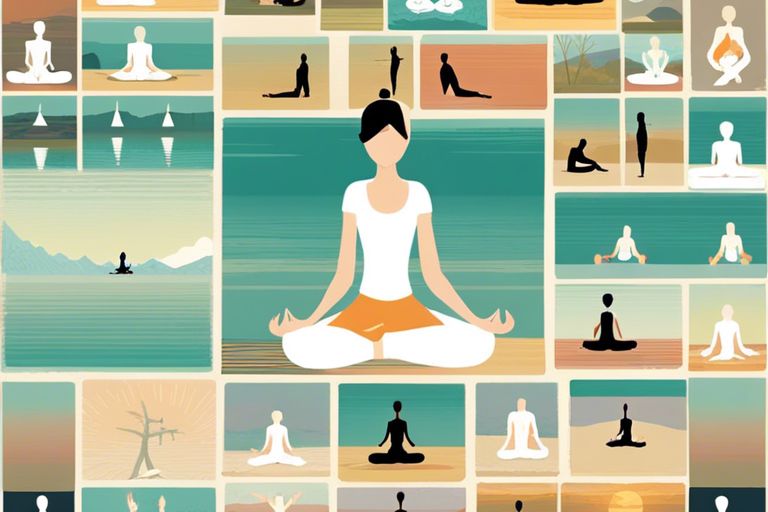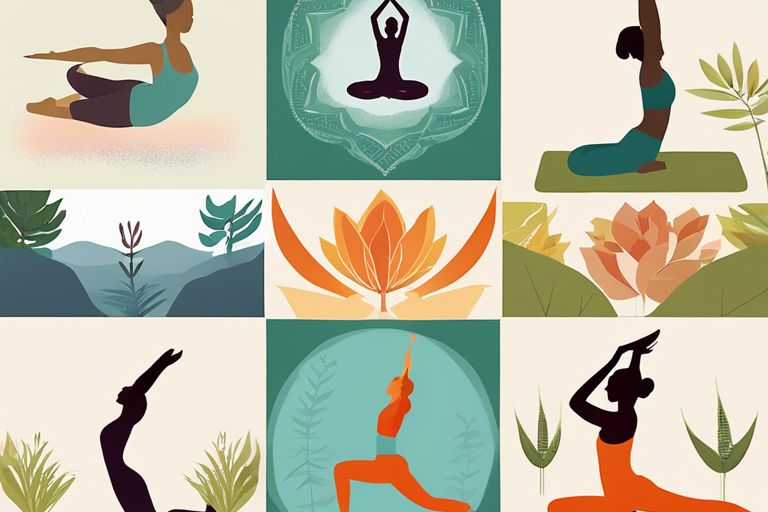Many fitness enthusiasts, like you, can benefit from incorporating yoga poses into your workout routine. This full body workout guide will help you achieve strength, flexibility, and relaxation all in one session. From Warrior Pose to Downward Dog, these top 10 yoga poses target different muscle groups while promoting mind-body connection. Get ready to enhance your fitness journey with this effective yoga routine.

Key Takeaways:
- Variety: Including a mix of standing, balancing, seated, and reclined poses provides a comprehensive full-body workout.
- Strength and Flexibility: Yoga poses like Warrior series, Plank, and Downward Facing Dog help build strength and promote flexibility in different muscle groups.
- Breath Awareness: Focusing on breath during each pose helps in improving concentration, calming the mind, and enhancing the mind-body connection.
1. Begin with Mountain Pose for grounding and centering.
2. Transition into Downward Facing Dog for upper body strength.
3. Move into Warrior II for lower body strength and balance.
4. Flow into Plank Pose to engage core muscles.
5. Try Bridge Pose to strengthen back and glutes.
6. Finish with Corpse Pose for relaxation and rejuvenation.
Understanding the Benefits of Yoga
Physical Benefits of Yoga
Now, let’s probe into the physical benefits of incorporating yoga into your routine. Yoga improves flexibility, strength, and posture as you move through various poses that target different muscle groups. Additionally, practicing yoga can help with balance and coordination, ultimately enhancing your physical performance in other activities. By engaging in a regular yoga practice, you can increase your muscle tone and build a stronger, more resilient body.
Mental and Emotional Benefits of Yoga
The mental and emotional benefits of yoga are just as significant as the physical ones. Yoga promotes relaxation and reduces stress by focusing on breathing techniques and mindfulness. It can help you cultivate a sense of inner peace and calm, even in the midst of a hectic day. Additionally, yoga can boost your mood and improve your mental clarity, allowing you to approach challenges with a more positive outlook.
To further emphasize the mental and emotional benefits of yoga, research has shown that yoga can lower levels of the stress hormone cortisol, reduce symptoms of anxiety and depression, and even enhance overall psychological well-being. Regular practice of yoga can contribute to better sleep quality, increased self-awareness, and a greater sense of emotional balance.

Types of Yoga Poses for a Full Body Workout
One of the best ways to achieve a full body workout through yoga is by incorporating a variety of poses that target different muscle groups. Yoga poses for toning are specifically designed to strengthen and tone muscles throughout your entire body. If you are looking to tone your body while practicing yoga, you can try incorporating 6 Yoga Poses That Will Tone Your Entire Body into your routine.
| Standing Poses for Strength and Balance | Seated Poses for Flexibility and Stretching |
| Supine Poses for Relaxation and Rejuvenation | Prone Poses for Core Strength and Stability |
Standing Poses for Strength and Balance
There’s nothing quite like mastering a standing yoga pose to feel a sense of strength and balance. Poses like Warrior I, Warrior II, Tree Pose, Crescent Lunge, and Eagle Pose can challenge your stability while toning your muscles. Perceiving your body’s alignment and engaging your core can help you maximize the benefits of these poses.
Seated Poses for Flexibility and Stretching
The seated yoga poses are perfect for increasing flexibility and stretching your muscles. Seated Forward Fold, Seated Twist, Cow Face Pose, Bound Angle Pose, and Half Lord of the Fishes Pose are excellent choices to stretch your hamstrings, hips, and spine. The deep stretches in these poses can help improve your overall flexibility and release tension in your muscles.
Supine Poses for Relaxation and Rejuvenation
Rejuvenation can be achieved through supine yoga poses that promote relaxation and release tension. Corpse Pose, Reclining Bound Angle Pose, Legs Up the Wall, Reclining Hand-to-Big-Toe Pose, and Happy Baby Pose are perfect for unwinding after a long day. These poses can help calm your mind, reduce stress, and rejuvenate your body.
Prone Poses for Core Strength and Stability
While focusing on prone yoga poses, you can work on building core strength and stability. Plank Pose, Locust Pose, Bow Pose, Sphinx Pose, and Crocodile Pose are great for targeting your abdominal muscles and lower back. With consistent practice, these poses can help improve your posture and overall core strength.
Top 10 Yoga Poses for a Full Body Workout
Mountain Pose (Tadasana) – Foundational Standing Pose
On your journey to a full body workout through yoga, the Mountain Pose, also known as Tadasana, is an crucial starting point. This foundational standing pose may seem simple, but it improves posture, strengthens your thighs, knees, and ankles, and firms your abdomen and buttocks. Stand tall with your feet together, grounding into the floor, and reaching towards the sky with your fingertips.
Downward-Facing Dog (Adho Mukha Svanasana) – Full Body Stretch
The Downward-Facing Dog, or Adho Mukha Svanasana, is a staple in any yoga routine due to its full body stretch benefits. Start on your hands and knees, then lift your hips up and back, forming an inverted V shape. This pose lengthens your spine, opens your shoulders, stretches your hamstrings, calves, and hands, as well as strengthening your arms and legs.
Plus, Downward-Facing Dog is excellent for relieving back pain, fatigue, and is known to calm the brain and help with stress and mild depression.
Warrior Pose (Virabhadrasana) – Strength and Balance
Virabhadrasana, or Warrior Pose, is a series of postures that cultivate strength, stability, and balance in your entire body. Warrior poses improve concentration, focus, and energize your entire being. These poses work on your legs, back, shoulders, and arms, providing a holistic full body workout experience.
Balance is key in the Warrior Pose series, as you ground down through your feet while reaching up towards the sky with your fingertips, finding the perfect harmony of strength and grace in each posture.
Triangle Pose (Trikonasana) – Flexibility and Stretching
Full body stretching and flexibility are the primary benefits of Triangle Pose, or Trikonasana. This standing pose strengthens your legs, opens your hips and chest, stretches your spine, and tones your waist. In Triangle Pose, you extend your arms and torso sideways while keeping your legs wide apart, forming a triangle shape with your body.
Body alignment and strong legs are crucial in Trikonasana, helping you achieve balance and length in the spine, while also improving digestion and reducing stress.
Seated Forward Fold (Paschimottanasana) – Hamstring and Back Stretch
On your path to a full body workout in yoga, Paschimottanasana, or Seated Forward Fold, provides a deep stretch for your hamstrings and back muscles. Sit on the floor with your legs extended in front, then hinge at the hips to fold forward over your legs. This pose relaxes the mind, soothes headaches, and reduces fatigue.
Paschimottanasana is particularly beneficial in toning the abdominal organs, stimulating the liver and kidneys, and improving digestion – all while calming the nervous system and reducing stress levels.
Plank Pose (Phalakasana) – Core Strength and Stability
For a full body workout that targets your core muscles, Phalakasana, or Plank Pose, is a must-do in your yoga routine. This pose strengthens your abdominals, arms, shoulders, and back muscles while improving overall body coordination and balance. Engage your core, keep your body in a straight line from head to heels, and hold the pose with steady breathing.
Adho Mukha Svanasana, the Plank Pose, boosts your metabolism, improves posture, and enhances your mood and self-confidence. Regular practice of this pose can lead to better endurance, increased flexibility, and a toned physique.
Tree Pose (Vrksasana) – Balance and Focus
Assuming Vrksasana, or Tree Pose, in your full body workout routine will challenge your balance and focus. This standing pose strengthens your legs, core, and ankles, while also improving concentration and mental clarity. Ground down through one foot, place the sole of the other foot on the inner thigh or calf, and bring your hands to your heart center.
Core stability and focused breathing are crucial in Tree Pose, as they help you find balance and harmony both on and off the mat. This pose encourages you to stand tall and unwavering, like a strong and steady tree in the wind.
Seated Twist (Bharadvajasana) – Spinal Flexibility and Detox
Flexibility in your spine and a detoxifying effect on your body are the primary advantages of Bharadvajasana, or Seated Twist, in a full body yoga workout. This seated pose, where you twist your torso to one side while keeping your spine long, helps improve digestion, stimulates internal organs, and relieves lower back tension. The twist wrings out toxins from your organs, purifying your body from the inside.
Tree Pose, the Seated Twist, encourages deep breathing, massaging your abdominal organs, and promoting spine health. Consistent practice of this pose can lead to a more supple, agile spine and a cleaner, healthier body overall.
Savasana (Corpse Pose) – Relaxation and Rejuvenation
After completing your intense full-body yoga workout, it’s vital to allow your body to relax and rejuvenate. Savasana, also known as Corpse Pose, is the ultimate relaxation pose that helps your body and mind unwind. This pose allows you to surrender completely, letting go of any tension or stress. It helps you integrate the benefits of the previous poses and promotes deep relaxation.
If you want to learn more about yoga poses for a full-body workout, check out 11 Yoga Poses for a Full-Body Workout to enhance your practice and overall well-being.
Boat Pose (Paripurna Navasana) – Core Strength and Balance
Relaxation from Savasana transitions into Boat Pose, a pose that targets your core muscles for a full-body engagement. In Boat Pose, you balance on your sitting bones while lifting your legs and torso to form a V shape. This pose strengthens your abdominals, hip flexors, and spine, boosting your core stability and balance. With consistent practice, Boat Pose can help improve your posture and enhance your overall physical strength.

Tips for a Successful Yoga Practice
All successful yoga practices require some imperative tips to enhance your experience and ensure you get the most out of each session.
Breathing Techniques for Optimal Energy
Little do you know that focusing on your breathing is crucial during your yoga practice. By incorporating deep, intentional breaths into each pose, you can elevate your energy levels and enhance the mind-body connection.
Alignment and Posture for Injury Prevention
Tips for proper alignment and posture are imperative to prevent injuries during your yoga practice. Ensuring that your body is in the correct position for each pose can help you avoid strain and discomfort.
Another important aspect of alignment and posture is to listen to your body and make necessary adjustments. Yoga is about finding balance and comfort in each pose, so don’t push yourself too hard and risk injuries.
Modifying Poses for Different Body Types
| Body Type | Modification |
|---|---|
| Beginner | Use props like blocks or straps for support |
| Flexible | Focus on strength-building poses |
| Inflexible | Take it slow and gradually increase flexibility |
| Pregnant | Avoid lying on the stomach and deep twists |
| Injured | Modify poses to avoid aggravating the injury |
There’s a modification for every body type in yoga poses that can help you tailor your practice to suit your individual needs. By making these adjustments, you can make yoga accessible and beneficial for everyone.
Creating a Consistent Practice Schedule
Creating a consistent yoga practice schedule is key to reaping the full benefits of yoga. By committing to regular practice, you can improve your flexibility, strength, and overall well-being.
Creating a routine that works for you, whether it’s a daily practice or a few times a week, can help you stay motivated and dedicated to your yoga journey. Techniques such as setting goals and tracking your progress can also keep you inspired along the way.
Step-by-Step Guide to Mastering Each Pose
Preparing for the Pose – Setting Up for Success
If you want to master each yoga pose in your routine, it’s crucial to prepare your mind and body for success. Start by finding a quiet and comfortable space where you can focus without distractions. Make sure to wear comfortable clothing that allows for freedom of movement. Additionally, using a yoga mat can help provide grip and cushioning for your practice.
| Tip: | Before starting your practice, take a few moments to center yourself with some deep breathing exercises to help calm your mind and prepare your body for the poses. |
Engaging the Correct Muscles – Activating the Core
Some yoga poses require specific muscle engagement to perform them correctly and prevent injury. In each pose, focus on activating your core muscles by drawing your navel in towards your spine. This engagement not only helps with balance and stability but also protects your lower back from strain.
| Tip: | Practice engaging your core muscles during simple poses or even while sitting or standing throughout the day to build strength and muscle memory. |
This core activation is crucial not only for mastering the poses but also for maintaining proper alignment and preventing injuries in your yoga practice.
Maintaining Proper Alignment – Preventing Injury
With every yoga pose, it’s crucial to pay attention to your alignment to avoid strain or injury. Keep your joints stacked in line with each other and pay attention to the positioning of your spine. Engage your muscles to support your joints and prevent overextension or compression.
| StepbyStep: | Check your alignment in the mirror or ask for feedback from a certified yoga instructor to ensure you are maintaining proper form throughout your practice. |
Breathing and Holding the Pose – Maximizing Benefits
Preventing holding your breath during a pose is crucial for maximizing the benefits of your practice. Focus on deep, steady breaths to oxygenate your muscles and calm your mind. Inhale as you lengthen your body and exhale as you deepen into the pose to enhance your flexibility and strength.
| Preventing: | Avoid sacrificing your breath for a deeper stretch; maintain a steady breath pattern to stay present and connected to your practice. |
Benefits of proper breathing not only enhance your physical practice but also help in reducing stress and improving mental clarity throughout your yoga routine.
Factors to Consider When Creating a Yoga Routine
Once again, when crafting your yoga routine, there are several factors you should take into account to ensure it is safe, effective, and aligns with your goals.
Age and Health Considerations – Modifying for Safety
An important aspect to consider when developing your routine is your age and health. It’s crucial to adapt poses to accommodate any physical limitations or medical conditions you may have. Consulting with a healthcare provider or a yoga instructor can help you modify poses to prevent injury and maximize benefits. Knowing your body and limitations is key to a safe and fulfilling practice.
Fitness Level and Goals – Creating a Challenging Routine
Now, your fitness level and goals play a significant role in shaping your routine. For instance, if you are looking to build strength and endurance, incorporating more challenging poses and sequences can help you achieve those goals. Tailoring your routine to challenge yourself while still respecting your body’s limits is vital for growth and progress.
Time Commitment and Schedule – Fitting Yoga into Your Life
Life can be hectic, but carving out time for yoga is important for your overall well-being. Consider your daily schedule and how much time you can realistically dedicate to your practice. Even short, consistent sessions can yield positive results for both your body and mind. Finding a balance that works for you is key to making yoga a sustainable part of your routine.
Environment and Equipment – Setting Up Your Yoga Space
With yoga, creating a peaceful environment can enhance your practice. Consider factors like lighting, ventilation, and clutter-free space to make your practice more enjoyable. Investing in quality equipment such as a yoga mat, blocks, and straps can also improve your comfort and stability into your poses. A dedicated yoga space can motivate you to stay consistent and focused in your practice.
To wrap up
Upon reflecting on the top 10 yoga poses for a full body workout, you now have a comprehensive routine that targets all major muscle groups, improves flexibility, and helps in reducing stress. By incorporating these poses into your regular practice, you can enhance your overall strength, balance, and endurance.
Remember to listen to your body and honor its limits while practicing these poses. Consistency is key, so try to perform this routine a few times a week to experience the maximum benefits of yoga for your body and mind. Keep in mind that yoga is a journey, and as you continue to practice and challenge yourself, you will continue to grow stronger and more connected to your body.
FAQ
Q: What are the top 10 yoga poses for a full body workout?
A: The top 10 yoga poses for a full body workout are:
- Downward-Facing Dog
- Plank Pose
- Warrior I Pose
- Warrior II Pose
- Triangle Pose
- Tree Pose
- Bridge Pose
- Boat Pose
- Chair Pose
- Cobra Pose
Q: How can a full body yoga routine benefit me?
A: A full body yoga routine can benefit you in various ways such as improving flexibility, strength, balance, posture, and mental focus. It can also help in reducing stress, improving overall well-being, and promoting relaxation.
Q: How often should I practice a full body yoga routine?
A: Ideally, it is beneficial to practice a full body yoga routine at least 3-5 times a week to see noticeable improvements in your physical and mental health. Consistency is key when it comes to reaping the benefits of a yoga practice.











